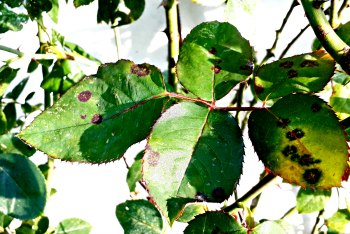Black Spot On Roses
One of the most widespread and serious rose disease is black spot on roses.

Black spots, often edged with yellow, develop on the foliage, especially on lower leaves.
The leaves will fall down and in severe cases defoliate the plant and sometimes infect the rose buds and stems, which will die back.
Many rose varieties will grow new foliage, but some will not withstand a second attack.
This is especially true for roses entering winter without foliage. More plants will die in winter from black spot disease than in summer.
How To Avoid Black Spot On Roses
In some parts of the country black spot is more common than in others as well as some roses are more prone to the disease than others.
It is always best to prevent diseases before they occur. What can we do to avoid the fungal spores to infect the leaves:
- Buy diseases-resistant varieties and buy them from a reputable company
- Plant the roses in sunny areas (6 hours sun) with good air circulation (go to Planting Roses for more information)
- Limit overhead watering to the morning hours that the leaves can dry up.
- Feed the plants regularly and in a proper manner; healthy plants are less prone to diseases
- Avoid potash shortage
- A layer of 2 inch mulch at the base of your rose will help avoid the spreading of the fungal spores
- Remove any diseased leaves and stems from the plant as soon as they appear
- Always remove and burn fallen and diseased leaves and clean up your pruning (Do not compost them)
Black spot is primarily a problem under rainy conditions because the fungal spores germinate on wet leaf surface. They must stay wet for at least 7 hours, to infect the foliage.
Treatment For Black Spot Disease
Despite all attention and care for your flowers, black spot can be difficult to control. Wet leaves overnight or a rainy day is all it takes, and the infection can start.
If the disease is a recurring problem, you have to spray the rose with fungicides at the first signs of infection.
Use a garden safe organic fungicide to help your roses. Once you had an infection on your plant, continue to spray regularly during the season.
After cleaning up your pruning before winter, use a dormant spray before the plant goes to hibernation.
Rose Gardening › Rose Diseases › Black Spot On Roses






New! Comments
Have your say about what you just read! Leave me a comment in the box below.